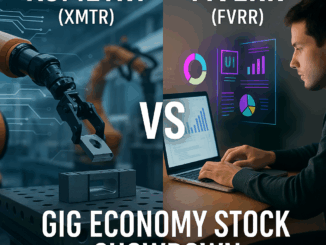
The gig economy has fundamentally reshaped how we work—and how investors think about future growth. From freelance marketplaces to app-based delivery services, gig-focused companies continue to disrupt traditional industries. If you’re looking to capitalize on this shift, gig economy stocks in 2025 offer exciting opportunities for long-term gains.
Here are 7 of the best gig economy stocks that could deliver significant upside in the years to come.
1. Uber Technologies (UBER): Scaling Beyond Ride-Sharing
Uber is no longer just a ride-hailing service—it’s a global logistics and mobility platform. In 2025, Uber is doubling down on food delivery (Uber Eats), freight, autonomous vehicles, and even electric bike rentals. As the company edges closer to consistent profitability, its diverse revenue streams and international expansion make it a core holding for anyone investing in the gig economy.
Why it stands out: Uber is the largest gig economy platform by user base and market cap, and its ecosystem is built to scale with future consumer behavior.
2. Fiverr International (FVRR): The Freelance Marketplace Powerhouse
As businesses cut costs and outsource more talent, Fiverr is well-positioned to thrive. Its streamlined platform connects freelancers and clients across hundreds of niches, from digital marketing to AI consulting. With a lean operating model and increasing take rate, Fiverr is quietly becoming one of the most efficient players in the freelance economy.
Why it stands out: High-growth potential in global markets and strong brand recognition in the freelance space.
3. DoorDash (DASH): More Than Just Food Delivery
DoorDash is expanding far beyond takeout. The company now delivers groceries, pet supplies, and retail goods, turning it into a decentralized logistics provider. For gig workers, DoorDash remains one of the most accessible platforms—while for investors, its operational scale and loyalty programs (DashPass) are powerful long-term moats.
Why it stands out: Innovative last-mile delivery solutions and market dominance in North America.
4. Upwork (UPWK): A Bet on Remote Work’s Staying Power
Upwork caters to freelance professionals and large enterprises alike. With companies increasingly seeking flexible labor, Upwork’s curated talent offerings and project management tools make it a go-to solution. The platform is also integrating AI to help match clients with freelancers faster—boosting both engagement and earnings.
Why it stands out: Strong business-to-business relationships and expanding monetization strategies.
5. Payoneer (PAYO): The Infrastructure Backbone for Freelancers
Every gig economy needs a payment processor, and Payoneer fills that role globally. The fintech company helps freelancers and small businesses receive cross-border payments quickly and affordably. With presence in over 190 countries, it’s one of the most underappreciated fintech plays supporting the gig economy.
Why it stands out: “Picks-and-shovels” business model with scalable infrastructure and strong regulatory positioning.
6. TaskUs (TASK): Outsourcing Meets the Gig Model
TaskUs provides outsourced digital services to some of the world’s fastest-growing tech companies. While not a gig platform per se, it leverages a remote, agile workforce in a way that mimics the gig economy. Its focus on content moderation, AI support, and customer service gives it a unique edge in a crowded outsourcing field.
Why it stands out: Niche business model with recurring enterprise revenue and strong margins.
7. Rover Group (ROVR): The Airbnb of Pet Services
Rover connects pet owners with dog walkers, sitters, and groomers—essentially turning pet care into a gig-based business. With pet ownership on the rise and remote workers needing more flexibility, Rover has carved out a loyal customer base. It’s a lesser-known stock with high upside potential as it scales beyond North America.
Why it stands out: High customer retention, low customer acquisition costs, and a rapidly growing vertical.
Conclusion: Building a Long-Term Gig Economy Portfolio
The gig economy is no longer a trend—it’s a structural change in how work gets done. Investing in gig economy stocks in 2025 allows you to ride the wave of flexible work, digital platforms, and global outsourcing. From logistics to freelance payments, these 7 stocks cover multiple layers of the gig infrastructure.
If you’re building a future-focused portfolio, consider these companies as essential long-term picks—and start your research now before Wall Street fully catches on.



Be the first to comment